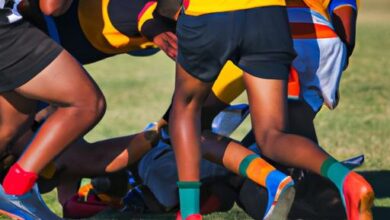Can You Play Rugby Without an ACL?

In the high-impact sport of rugby, the Anterior Cruciate Ligament (ACL) plays a vital role in stabilizing the knee joint during dynamic movements. But what happens if you suffer an ACL injury? Can you still play rugby without an ACL? Let’s delve into this topic and explore the possibilities.
An Overview of ACL and its Importance in Rugby
The ACL is one of the major ligaments in the knee, connecting the thigh bone to the shin bone. Its primary function is to prevent excessive forward movement of the shin bone and rotational instability of the knee joint. In rugby, where quick turns, sudden stops, and aggressive tackles are commonplace, a healthy ACL is crucial for stability and optimal performance.
Understanding ACL Injury and its Impact on Playing Rugby
Unfortunately, ACL injuries are not uncommon in rugby. When the ACL gets overstretched or torn due to a sudden change in direction, a collision, or an awkward landing, it can lead to severe pain, swelling, and instability. These injuries can significantly impact a player’s ability to perform at their best and may even require surgical intervention.
ACL injuries can result in prolonged recovery periods, sometimes requiring months of rehabilitation before returning to the field. Moreover, studies have shown that the risk of developing osteoarthritis in the knee joint increases after an ACL injury, further highlighting the importance of this ligament in maintaining long-term joint health.
In the next section, we will explore the effects of ACL injury on rugby players and delve deeper into whether it is possible to play rugby without a functional ACL. Stay tuned!
Understanding the ACL and its Function
The Role of ACL in Stabilizing the Knee Joint during Physical Activities
The ACL is a critical component of the knee joint, working in tandem with other ligaments, tendons, and muscles to provide stability and support during physical activities. It acts as a primary restraint, preventing excessive forward movement of the shin bone (tibia) and rotational instability of the knee joint.
Importance of ACL in Rugby and its Impact on Player’s Performance
In the fast-paced and physically demanding sport of rugby, the ACL plays a vital role in ensuring players can perform at their best. It provides stability during rapid changes in direction, sudden stops, and powerful movements such as tackling or jumping. Without a healthy and functional ACL, rugby players may experience difficulties with balance, agility, and overall movement control, compromising their performance on the field.
Rugby requires players to engage in dynamic movements that place immense strain on the knee joint. The ACL helps absorb and distribute these forces, protecting the knee from injury. Additionally, it provides the necessary stability for players to confidently perform quick pivots, cuts, and directional changes, essential aspects of the game.
In the upcoming section, we will explore the effects of ACL injury in rugby players. Stay tuned to learn more about the consequences of ACL injuries and whether it is possible to continue playing rugby without an ACL.
Effects of ACL Injury in Rugby Players
Consequences of ACL Injury in Rugby
When an ACL injury occurs in rugby, the consequences can be significant. The immediate impact often includes intense pain, swelling, and difficulty in bearing weight on the affected leg. This can lead to a player being sidelined for an extended period, unable to participate in training sessions and matches.
Impact on Mobility, Stability, and Overall Gameplay
The ACL serves as a crucial stabilizer of the knee joint, allowing for smooth and controlled movements. Without a functional ACL, rugby players may experience reduced mobility and stability, hindering their ability to perform quick direction changes, pivots, and tackles effectively. The lack of stability can affect acceleration and deceleration, making it challenging to keep up with the fast-paced nature of the game.
Prevalence of ACL Injuries in Rugby Players and Associated Risks
ACL injuries are unfortunately prevalent in rugby, particularly among athletes engaged in high-impact contact sports. Research has shown that rugby players face a higher risk of sustaining ACL injuries compared to athletes in other sports. The combination of sudden stops, powerful collisions, and pivoting motions increases the vulnerability of the ACL to injury.
Moreover, the risks associated with ACL injuries extend beyond the immediate impact. Players who have suffered ACL injuries are at a higher risk of re-injury and developing long-term knee problems, such as osteoarthritis. These potential long-term consequences highlight the importance of taking preventive measures and seeking proper medical attention when dealing with an ACL injury.
In the next section, we will explore the possibility of playing rugby without an ACL and the factors that come into play. Let’s find out if it’s still possible to embrace the sport we love, even with this significant challenge.
Can You Play Rugby Without an ACL?
Exploring the Possibility
The question on many rugby players’ minds is whether it is possible to continue playing the sport without a functional ACL. While the ACL plays a crucial role in knee stability, it is not entirely impossible to participate in rugby without it. However, several factors come into play when considering this option.
Factors Influencing Feasibility
The feasibility of playing rugby without an ACL depends on various factors, including the severity of the injury, individual physiology, and personal goals. In some cases, individuals with partial or minor ACL tears may be able to continue playing with proper rehabilitation and strengthening exercises. However, it is vital to consult with a medical professional to assess the extent of the injury and receive personalized advice.
Case Studies and Experiences
Numerous rugby players have faced the challenge of playing without a functioning ACL. While each case is unique, some athletes have successfully adapted their playing style and continued their rugby careers. These players often emphasize the importance of compensating for the lack of ACL stability through strengthening surrounding muscles, wearing supportive braces, and relying on proper technique.
It is worth noting that playing rugby without an ACL does come with risks. Increased instability in the knee joint can make individuals more susceptible to further injuries. Additionally, the absence of an ACL may limit agility and quick changes in direction, potentially affecting overall performance on the field.
In the next section, we will explore considerations and precautions that individuals should keep in mind when playing rugby without an ACL. Join me as we dive deeper into this topic!
Considerations and Precautions for Playing Rugby without an ACL
Proper Medical Evaluation and Advice
Before making any decisions about playing rugby without an ACL, it is crucial to seek proper medical evaluation and advice. A qualified orthopedic specialist or sports medicine professional can assess your specific condition, taking into account factors such as the severity of your ACL injury, overall knee stability, and individual circumstances. They will provide expert guidance on whether it is safe for you to continue playing rugby without an ACL or if alternative options should be considered.
Preventive Measures and Strengthening Exercises
While playing rugby without an ACL may be possible for some individuals, it is essential to take preventive measures to reduce the risk of further injury. Strengthening the surrounding muscles, such as the quadriceps, hamstrings, and calf muscles, can help provide additional support to the knee joint. Working with a physical therapist or strength and conditioning coach to develop a tailored exercise program can enhance overall knee stability and minimize the strain on the remaining ligaments.
Additionally, focusing on maintaining proper body mechanics and technique during rugby activities can help reduce the chances of further knee injuries. Learning how to land safely, pivot effectively, and change direction while keeping the knee joint aligned can make a significant difference in minimizing the risk of additional damage.
Role of Protective Gear and Bracing
Protective gear, including knee braces, can provide added support and stability to the knee joint during rugby activities. Knee braces specifically designed for ACL injuries can help restrict excessive movement and reduce the risk of further damage. However, it is important to note that knee braces alone cannot fully compensate for the absence of the ACL. The use of protective gear should always be accompanied by proper strengthening exercises and adherence to preventive measures.
Remember, every individual’s situation is unique, and what works for one person may not work for another. It is crucial to consult with medical professionals who can provide personalized advice based on your specific circumstances. With proper evaluation, precautionary measures, and guidance, it may be possible to continue playing rugby without an ACL while minimizing the risk of further injury.
Considerations and Precautions for Playing Rugby without an ACL
Playing rugby without a functional ACL is a challenging endeavor that requires careful consideration and precautionary measures. While some individuals may choose to continue participating in the sport, it is crucial to understand the potential risks and take necessary steps to minimize further injury.
Seeking Medical Evaluation and Advice
Before deciding to play rugby without an ACL, it is imperative to consult with a medical professional who specializes in sports injuries. They can evaluate your specific condition, assess the stability of your knee joint, and provide personalized guidance. Their expertise will help you make an informed decision based on your individual circumstances.
Preventive Measures and Strengthening Exercises
Engaging in specific preventive measures and strengthening exercises can help reduce the risk of further knee injuries. Working with a physical therapist or a sports trainer, you can focus on exercises that strengthen the muscles around the knee joint, such as quadriceps, hamstrings, and calf muscles. These exercises can provide additional support to the knee, compensating for the lack of ACL stability.
Protective Gear and Bracing
Protective gear, such as knee braces, can provide external support and stability to the knee joint during rugby activities. While they cannot completely replace the function of the ACL, they can offer an added layer of protection. It is essential to consult with a healthcare professional to determine the most suitable type of brace for your specific needs.
In conclusion, playing rugby without an ACL is a complex decision that should not be taken lightly. Seeking professional medical advice, focusing on preventive measures, and utilizing protective gear can help minimize the risk of further injury. Remember, the ultimate goal should always be to prioritize your long-term health and well-being.
Conclusion: So above is the Can You Play Rugby Without an ACL? article. Hopefully with this article you can help you in life, always follow and read our good articles on the website: pet.top5dalat.com




